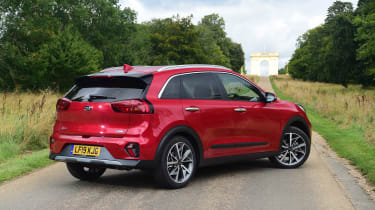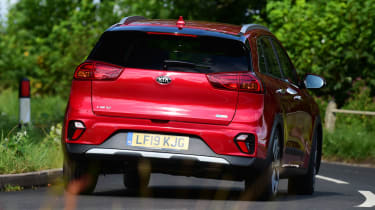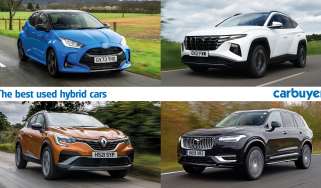Kia Niro SUV - Engines, drive & performance (2016-2022)
If you prefer relaxed and peaceful driving, the Kia Niro will suit, as it’s no sports car
The Niro isn’t a car you’d want to take for a quick drive down your favourite country lanes – it’s better suited to town driving or relaxed cruising and it does this very well. The transition between battery and petrol power is seamless and the car is quiet at all times – even when the engine is running, it only gets intrusive when being worked really hard. A Sport mode tells the engine to respond more sharply, as well as reducing the power assistance to give the steering a greater sense of weight, but the latter isn't particularly convincing.
If judged against similarly-proportioned crossover rivals like the Mazda CX-3, the Niro doesn’t impress in corners. Its steering is quite direct but lacks much in the way of feel, and its low-resistance tyres aren’t especially grippy. However, its dual-clutch automatic gearbox does have advantages over the CVTs in hybrid rivals: the car is quieter because of it and feels far more responsive when you put your foot down. Its handling is also viceless and safe; despite the Niro’s hefty bulk, abrupt direction changes can be made without drama.
Kia Niro hybrid engines
The Niro has a 1.6-litre turbocharged petrol engine that (in combination with the electric motor) produces 139bhp and is capable of taking the car from 0-62mph in a reasonable 11.1 seconds. It remains quiet in everyday driving and feels nice and punchy around town if you’re trying to pull out of a side road quickly, but head out on the motorway and it begins to feel out of its depth. As it only has a six-speed gearbox, it often has to hold on to a gear longer than you might expect when accelerating or climbing hills, resulting in a droning noise from the engine that can become annoying.
More reviews
Gear changes are at least smooth, though, while you can swap gears yourself using a shifter mounted on the centre console should you wish. You may find you want to do so when overtaking, as the transmission can be slow to ‘kick down’ a gear when you push the accelerator to the floor. It all adds up to a fairly dull and uninvolving experience for the keen driver, yet if all you want is unfussed A to B progress, the Niro will be absolutely fine.
The Niro PHEV has the same 1.6-litre GDi petrol engine as the conventional hybrid, with 104bhp, but a more powerful electric motor and a bigger battery, for a total combined output of 139bhp - the same as the hybrid. Its 10.4-second 0-62mph time is a little quicker, but the Niro PHEV can feel sluggish to drive. Press the accelerator firmly and the petrol engine will kick – perahps more readily than we'd like. Learn to be more gentle and the Niro becomes a more satisfying car to drive, picking up speed in near silence.
For most eco-conscious crossover drivers, it should be quick enough, but enthusiasts are likely to plump for the MINI Countryman Cooper S E ALL4 instead, offering 0-62mph in 6.9 seconds and a far more engaging drive – for not a lot more money.
There are two driving modes in the plug-in Niro: EV and HEV, with the former maximising use of the electric motor, and the latter working more like a conventional hybrid. It’s possible to stay in EV mode at higher speeds, but the Niro tends to prioritise the petrol engine on the motorway.
The electric-only e-Niro model is by far the fastest model in the line up, with 0-62mph taking a sprightly 7.5 seconds. Although it’s heavier, the battery pack is mounted low down so as not to upset the car’s centre of gravity, so it feels quite stable in corners.
Which Is Best?
Cheapest
- Name1.6 GDi 127 Hybrid 2 Nav 5dr DCT
- Gearbox typeAuto
- RRP£30,085
Most Economical
- Name1.6 GDi 168 PHEV 2 5dr DCT
- Gearbox typeAuto
- RRP£35,325
Fastest
- Name1.6 GDi 168 PHEV 2 5dr DCT
- Gearbox typeAuto
- RRP£35,325















